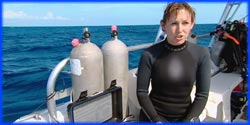


Premier Date: October 7, 2012
plausible
To begin testing the buoyancy of the wooden board, Adam made 1/4 scale dolls of Jack and Rose and a 1/4 scale replica of the board made of white oak. After floating the board in salt water and putting the Rose doll on top, the results were visually similar to what was shown in the movie. When Adam tried to add the Jack doll to the board it sunk every time; it was only buoyant enough to keep Rose out of the water.
The second question in this myth involved hypothermia and whether staying on top of a floating board would even help a person survive the cold. Jamie created a sophisticated gelatin dummy (dubbed Thermo-man) that was filled with coiled copper tubing to simulate the cardiovascular system of a human. Water was pumped through the tubing and heated with a 300 watt fish tank heater, simulating the heat produced by human metabolism. Under normal conditions the heater kept the dummy’s “blood” heated to normal body temperature, 98.6°F (37.0°C).
The Director of Titanic, James Cameron, appeared on the show to provide some details from the movie that were unclear. He explained that Rose was rescued roughly 63 minutes after the ship sank. He also explained that records from the night of the sinking show that the water temperature and the air temperature were both 29°F (-2°C).
The dummy, with it’s temperature at 98.6°F (37.0°C) was immersed in 29°F (-2°C) water. After 49 minutes its temperature was at 84.5°F (29.2°C). Jamie explained that at temperatures below 85°F (29.4°C), a human would be in an immobile stupor and would drown. The dummy was re-heated to normal temperature and left in 29°F (-2°C) air while wearing wet clothes. This time, after 49 minutes, its temperature was at 85.3°F (29.6°C). Although this was not a major difference in temperature, floating on the board would at least prevent drowning and allow the potential for rescue. At the rescue time of 63 minutes, the dummy’s temperature was 82.5°F (28.0°C) and it was explained that temperatures over 82°F (27.8°C) would still allow the possibility of survival.
So far the conditions in the movie appeared to be correct: Jack would have drowned, and Rose could have held on long enough for rescue.
To test the buoyancy of the board at full scale, Jamie and Adam stood in for Jack and Rose, and a piece of debris, accurate to the movie and to the time period, was built. To account for their additional mass over the characters, Adam and Jamie added some cork to the bottom of the board to increase its buoyancy. Initially the pair struggled to both stay afloat on the board. However, they realized that Rose (Jamie) was wearing a life jacket and they could tie it under the board to make it float better. Now, they were both able stay on the board and keep most of their bodies out of the water. With this extra possibility, the myth was declared plausible.
busted
The Built Team started their tests with Buster and one large rocket motor (K class) attached to a normal surf board. At a lake a 20 foot (6 m) guide rail was used to assist the launch. Buster and the surfboard immediately did a somersault because of the intensity of the thrust.
Next, they decided to see how much acceleration a person (Tory) on a skateboard could handle without falling off. Tory was able to stay on the board with an acceleration of 0.8 G.
To get a gentler rocket push, the team used a series of smaller rocket motors. Tests with a weighted surf board showed that 20 of the smaller rocket engines provided sufficient acceleration to get the board to 20 mph, and additional stages of motors on a timed fuse could be ignited every 2.5 seconds to maintain the speed.
For for their final tests, the surf board was widened and modified with a keel weight for improved stability. Both Buster and Tory had reasonably successful runs on this surf board but the ride did not last 30 seconds or reach 20 mph (32 km/h). Because of this and because they had to use multiple engines and a modified board, the myth was busted.
Previous: Special 19: Jawsome Shark Special